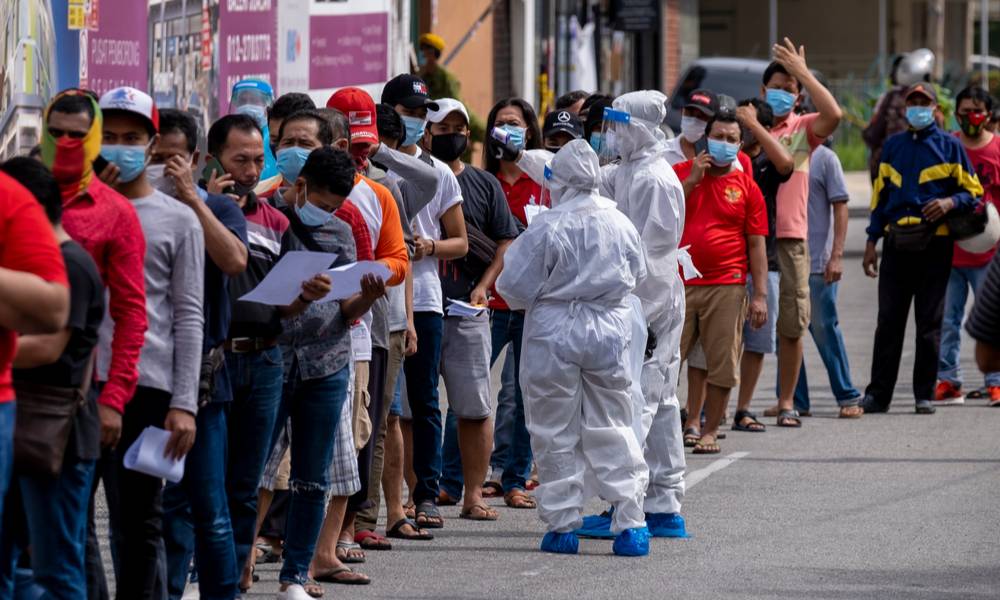Analytics, risk and managing the 21st century supply chain
Hospitals and health centres around the world are struggling to keep pace with the surge in demand post-COVID-19, and while it is difficult to predict future outbreaks, combining several analytics-based tools can help prepare in the future, write Wharton's Michael Ferrari and Raghu Iyengar
This article is republished with permission from Knowledge @ Wharton, the online business journal of the Wharton School at the University of Pennsylvania, which owns the copyright to this content.
The business of moving goods from their point of origin to their destination anywhere on Earth is no small task, and the risks seem to be growing. As the COVID-19 pandemic is making painfully clear, in this time of crisis, several challenges are associated with providing caregivers with basic tools and remedies, which we all take for granted. Hospitals and health centres around the world are struggling to keep pace with the surge in demand for test kits, basic medical supplies, personal protective equipment and life-saving drugs to satisfy existing demand and prepare for the expected increase in cases in the coming weeks and months related to the coronavirus outbreak.
It is indeed difficult to predict when, where and how these outbreaks may occur and spread. What we can do is be better prepared for when these episodes arise and lessen the risk and disruption by combining several analytics-based tools that are now just becoming commonplace in supply chain discussions: blockchain and location intelligence.
Globalisation can bring numerous benefits, but these come with risks. Each global economic enterprise needs to assess value, and more importantly, physical and financial risks that are embedded within a fragile system. This is where the tools and techniques that are housed in the domains of decision sciences and analytics can have an enormous impact.
The last several years have seen a dramatic rise in the analytics and decision sciences departments across nearly every commercial organisation of every size. Given the current supply chain disruption in personal protective equipment (PPE) supplies due to the pandemic, the combination of two analytic tools — blockchain and location intelligence — can serve as an effective hedge against business disruption. Managing risk properly using these complementary tools can shift the COO, CIO, CAO, or CMO’s conversation from one of risk to one of opportunity and competitive advantage.

So, in light of the recent disruption to the world economy, we should be using this moment to think about how and when we come out of this. Can we view and manage supply chain risk but do so through a different lens? Knowing where goods and raw materials are, and how to quickly respond to ensure that the right materials arrive at the right places at the correct times (think PPE and medical supplies to overburdened emergency rooms), will only increase in importance as global supply chains become even more precarious. Making use of blockchain and location intelligence technologies will allow managers to identify risk better and respond early when a pending supply disruption arises. Here we offer some insights regarding how the risk manager of the future may use these tools.
Implementing blockchain
In their 2018 Wharton/Mack Institute white paper, the authors outlined challenges and critical questions associated with blockchain implementation. Included in their discussion was a compelling debate on the Interparty Transactions Index (ITI) and Infrastructure Readiness Index (IRI), which respectively address the risk associated with the number of parties involved (the larger number of suppliers has a higher risk score) and the scalability of network transactions. If we look at just one form of PPE that is in short supply today, supply chains involve raw materials, industrial chemicals, and shipping routes that touch dozens of countries in nearly every continent. The case for blockchain implementation to (a) track and secure orders and deliveries, and (b) respond to existing or anticipated supply chain threats transparently and efficiently is justified in the context of the current crisis.
Enter location intelligence
Complementing the ‘what’ — transactional risk through the use of blockchain — is the ‘where’ in the equation. Geospatial and location intelligence (LI) technologies can help pinpoint the flow of both primary and alternate materials. With the ubiquitous expansion of sensors and the rise of the associated infrastructure that can capture, transmit and disseminate data that is collected from these devices, we are moving towards a world where the movement of every person, object, product or transaction leaves a digital footprint. Using geospatial technologies, we can add a static or dynamic market to this data, so in theory, we not only know what is happening, but we also know where and when.

When it comes to location intelligence, we immediately think of tracking the location of ourselves. Every current discussion of location tracking technology includes an immediate concern around privacy. Again, this scenario is playing out in real-time with respect to a debate around personalised information and attempts to control the spread of the coronavirus across populations. While privacy concerns are valid, geospatial technologies are proving to be an indispensable tool for epidemiologists trying to assess vulnerabilities and hotspots. Several governments (e.g., Italy, Israel, South Korea) are using location information of individuals using mobile data, and this has helped in managing both the anticipation and the control of the spread of the coronavirus within and across populations.
However, there is also an opportunity to extend this digital tracer to every good, commodity or exchange that touches the global supply chain. Geospatial technologies have altered how we view, interact with and make sense of the world, while the deployment of these tools has also provided new insights related to the ways in which we examine how the flows of goods, services, people and information comprise the global economy. An example of novel uses of supply chain mapping includes Sourcemap, which provides a unique data delivery system for users wanting to better understand the sustainability implications within their supply chains.
As nearly all data is now accompanied with a georeferenced timestamp, we are now able to track and model this data point as it moves through supply chains and transportation systems, interacting with other data points, and providing the raw material that allows us to construct a new suite of digital models. When we couple this location-based signature with a secure yet globally accessible digital accounting system, it becomes feasible to know where every node in the global economic puzzle resides. Further, when there are threats or disruptions to the system, a system that has been shown to be fragile, the marrying of these tools allows for alternative methods to manage risk and optimise the response.

Blockchain + geography = supply chain sustainability
When we fuse blockchain with LI, the notion of rigid borders as they pertain to supply chain flow begins to dissolve. Supply chain and business continuity risk seem to become more vulnerable to shocks; these can be the result of weather/natural disasters, energy prices, foreign exchange fluctuations, or trade disputes, among other causes. This susceptibility becomes magnified when the origination, distribution and flow of commercial commodities are all interconnected, and it becomes clear that regions have begun to supersede countries with respect to supply chain continuity. It is in the best interest for supply chain personnel at any given time to have the ability to identify risk (or opportunity) to materials and products and immediately know: (a) where the risk is, (b) what is the catalyst, (c) what are the transactional costs associated with alternatives and (d) what are the physical and financial options associated with enacting a contingency plan. Being able to isolate where, when, why at a granular level leads to both a competitive advantage and a more efficient, flexible global supply chain.
Noted author and global strategist (and colleague) Parag Khanna has pointed out in Connectography: “It is time to re-imagine how life is organised on Earth. We’re accelerating into a future shaped less by countries than by connectivity.” The future of work has become a common fixture among businesses, technology conferences and universities around the world. Accompanying the global digitisation transformations are questions and debates addressing topics including how society will work in the future, what types of jobs will be created and eliminated, and how will we create, manufacture and distribute more goods and services to a growing population, while using fewer human and energy resources.

It seems like the current situation has provided a glimpse of the future as we may be living some of this real-time experiment today. The future, at the moment, is uncertain. As Parag implied, connectivity to physical, network, financial and most importantly geographic resources may determine the direction of the new global economy. Blockchain and location intelligence technologies will have a very important role in this transition.
Smarter supply chains
According to a recent report from IBM, systems based on exponential technologies, like blockchain, can help organisations build smarter supply chains and reduce vulnerabilities in global pandemics — or other unforeseen circumstances. Smarter supply chains that leverage emerging technologies can help companies maintain business continuity amid disruption and uncertainty. According to Paul Walsh, the Global Director of Consumer Weather Strategy at IBM Services Weather and Climate Center of Competency: “Within our own IBM Systems supply chain, we have developed cognitive control tower capabilities to identify early warnings based on external data, such as social media or The Weather Company insights. As a result, our supply chain professionals have relevant and actionable information at their fingertips, allowing them to quickly respond to disruptions.” It is becoming clear that analytics tools which combine expertise from a variety of domains will be the key to comprehensive risk management in the 21st century.
It is important to note that blockchain, LI, and other related technologies are not a panacea for all things related to supply chain risk. However, the benefits associated with globalisation do not come without risks, and the use of these should be carefully evaluated and implemented with caution. Those managing the movement of goods, services, or currency around the world bear some responsibility if the global supply chain is to continue to service the needs and requirements of more than 7 billion people, and the threat of disruption appears to be growing. Here are some guidelines that are important to consider.

First, it is prudent for supply chain managers, where appropriate, to employ both blockchain and location intelligence tools. Managing business continuity while allowing ample time and precision to proactively take action in the event of a disruption benefits companies of every size in every industry.
Second, these tools cannot be utilised in isolation, and only serve as part of the puzzle with respect to the global commercial ecosystem. There are many developments that have become available to industry in recent years ranging from the blockchain and geospatial capabilities that we describe, to real-time tracking with sensors, satellites and financial data feeds. Exposures vary by industry and having the ability to choose which tools are appropriate for which use cases allows for customisable solutions that fit the user’s risk tolerance profile.
Finally, as much as technology can help businesses operate more efficiently in the face of a pending crisis, it does not replace the human element in the decision-making process. Perhaps part of the reason the world is facing this crisis may be related to the world being over-optimised. When the goal is efficiency at all costs, little slack is built into the system, and when a disrupting event presents itself, the lack of a safety net results in larger problems. Business operations will evolve, and the use of technology can best be utilised when it augments the decision-making process, not defines it.
The current crisis has fundamentally disrupted the way we go about conducting our lives. Still, it also provides an opportunity to learn how best we can prepare ourselves for the next time such a global event occurs. While the root cause in this instance was the rapid spread of a dangerous strain of the virus, this ‘trigger event’ could well have been any number of catalysts that scale and quickly act as a global disruptor. The key will be how leaders and organisations use this disruptive global event to apply analytics-based tools such as blockchain and location intelligence and react to a changing marketplace where timelines will only get shorter and riskier.
Michael Ferrari is the global head of climate and agronomic decision sciences at Syngenta and a senior fellow at Wharton. Raghu Iyengar is a professor of marketing at Wharton and faculty director of Wharton Customer Analytics.

